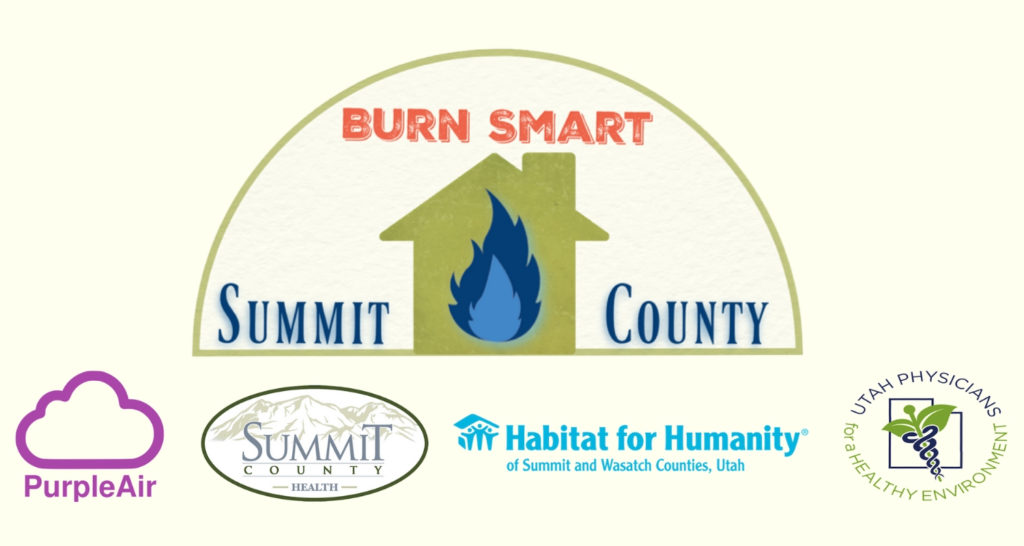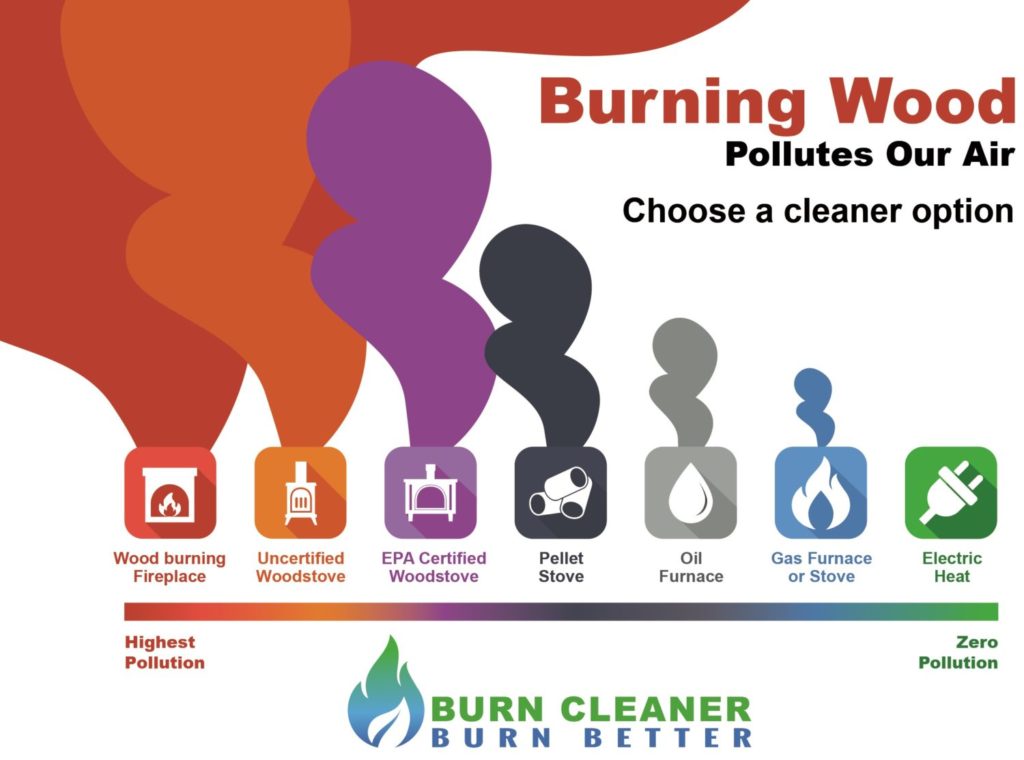
Burn Smart Summit County — Frequently Asked Questions
Learn all about Burn Smart Summit County on the Summit County Healthcast podcast.
What is Burn Smart?
Burn Smart is a wood burning appliance exchange program funded specifically to Summit County. During the next few months we will be replacing wood burning appliances in the area as part of our pilot program to begin improving air quality and gather data to educate our community about the harmful effects of wood smoke.
How is this program funded?
“Burn Smart” is funded by an EPA Environmental Justice grant awarded to Utah Physicians for a Healthy Environment and partners Habitat for Humanity of Summit and Wasatch Counties, Summit County Health Department and Purpleair. The grant was awarded to improve air quality for families in Summit County.
How much money will I receive?
This grant program can cover between $500 and $4,000 of your actual costs. The award amount is dependent on several factors (including income levels and individual project complexity) that we will be able to explain to you after you submit an application.
Do you have any details outlining the income requirements?
We will be using the table below as a guide for fund disbursement:
| Income | $65,880 | $65,880 – $109,800 | >$109,800 |
| AMI | < 60% | 60 – 100% | >100% |
| Subsidy | Up to $4,000 | Up to $1,500 | $250 Incentive |
By filling out the form am I agreeing to have my stove removed or do I have a choice based on the funding offered?
By completing the application, you are only showing your interest in participating in the program. Once we are able to determine certain case by case factors (such as: the grant subsidy amount, feasibility of project and your ability to participate in air monitoring) you will have the option to continue in the program or withdraw. *
*those who withdraw are generally eligible to apply again in the future.
I submitted the form but could not attach the requested documents. Could I email it to you when I get it?
There are more places to attach documents at the bottom of the online form. You can also set an appointment with Brianna to submit the documents in person (brianna@habitat-utah.org).
My insurance is part of our mortgage payment and there isn’t a tab for that. How do I record that in the application?
Submit the copy of your mortgage payment. It should include tax/insurance information. If more documentation is needed, we will notify you.
I submitted my application online. Can I confirm that it was received?
You can expect to hear from us within two weeks of submitting your complete application.
When do you think you will be letting us know if we will receive the grant?
We will have an answer for you within two weeks of submitting your completed application and full documentation.
Is it worth applying if I cannot pay the portion that is not covered by the grant?
Of course! We always encourage you to apply! We cannot know for certain your subsidy until we look at an application. If you are interested in replacing your appliance it is always a good idea to see what level of the grant you will qualify for. In some cases, we may be able to pay for the majority of the cost.
How much do gas fireplaces generally cost?
The average fireplace insert installation and wood stove replacement cost around $4,500. There are many factors into the cost, but it mostly depends on the stove you select and if your home is equipped with a gas line.
More about the harmful effects of wood smoke:
What is wood smoke?
Smoke forms when wood or other organic matter burns. The smoke from wood burning is made up of a complex mixture of gases and fine particles (also called particle pollution, particulate matter, or PM). In addition to particle pollution, wood smoke contains several toxic harmful air pollutants including benzene, formaldehyde, acrolein and polycyclic aromatic hydrocarbons (PAHs).
Health effects of wood smoke?
Smoke may smell good, but it’s not good for you. The biggest health threat from smoke is from fine particles, also called fine particulate matter or PM2.5. These microscopic particles can get into your eyes and respiratory system, where they may cause burning eyes, runny nose, and illnesses, such as bronchitis. Fine particles can make asthma symptoms worse and trigger asthma attacks. Fine particles can also trigger heart attacks, stroke, irregular heart rhythms, and heart failure, especially in people who are already at risk for these conditions.
Who is at risk from wood smoke?
Wood smoke can affect everyone, but children, teenagers, older adults, people with lung disease, including asthma and COPD or people with heart diseases are the most vulnerable. Research indicates that obesity or diabetes may also increase risk. New or expectant mothers may also want to take precautions to protect the health of their babies because some studies indicate they may be at increased risk.
It’s important to limit your exposure to smoke—especially if you are more susceptible than others:
- If you have heart or lung disease, such as congestive heart failure, angina, chronic obstructive pulmonary disease, emphysema or asthma, you may experience health effects earlier and at lower smoke levels than healthy people.
- Older adults are more likely to be affected by smoke, possibly because they are more likely to have chronic heart or lung diseases than younger people.
- Children also are more susceptible to smoke for several reasons: their respiratory systems are still developing; they breathe more air (and air pollution) per pound of body weight than adults, and they’re more likely to be active outdoors.
Impacts from Wood Smoke
Because wood doesn’t burn completely, wood smoke contains a wide range of harmful substances. Pollutants in wood smoke include particulates, volatile organic compounds (VOCs), and hazardous air pollutants (HAPs), some of which are toxic or considered carcinogenic. These pollutants include:
- Benzene
- Formaldehyde
- Carbon monoxide
- Nitrogen dioxide
- Particulates
- Polycyclic aromatic hydrocarbons (PAH)
- Sulfur dioxide
Health Effects
Because the fine particles in wood smoke are too small to be filtered out by the upper respiratory system, they lodge deeply into the lungs, causing irritation and decreasing lung functioning. The toxic and carcinogenic chemicals that are released in wood smoke can bind with these particles, compounding the health impacts. Short-term exposures to particles can aggravate lung disease, cause asthma attacks and acute bronchitis, and increase susceptibility to respiratory infections.
People with heart or lung disease, such as congestive heart failure, angina, chronic obstructive pulmonary disease, emphysema, or asthma may experience health effects earlier and at lower smoke levels than healthy people. Older adults are more likely to be affected by smoke, possibly because they are more likely to have chronic heart or lung diseases than younger people. Children also are more susceptible to smoke because their respiratory systems are still developing, they breathe more air per pound of body weight than adults, and they’re more likely to be active outdoors.
Numerous studies link particulate levels to increased hospital admissions, emergency room visits, and even early death. Research indicates that obesity or diabetes may increase the risk. Some studies also suggest that long-term PM2.5 exposure may be linked to cancer and to harmful developmental and reproductive effects such as infant mortality and low birth weight.


